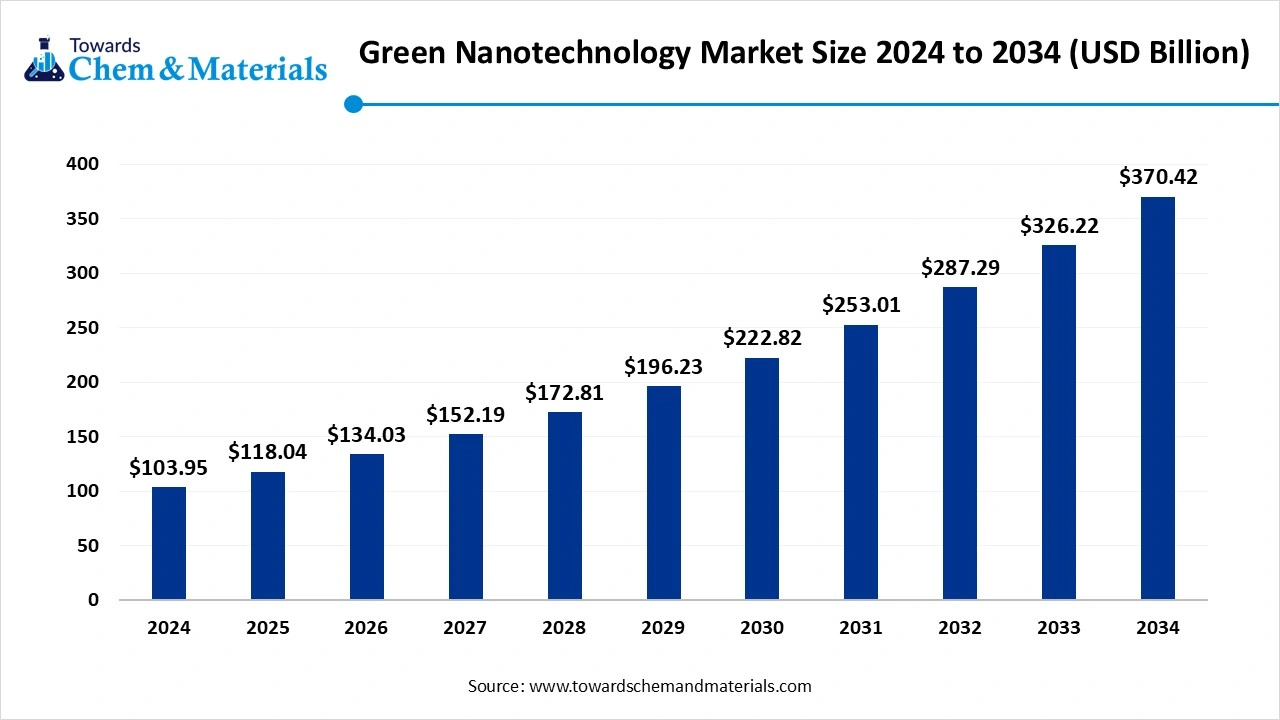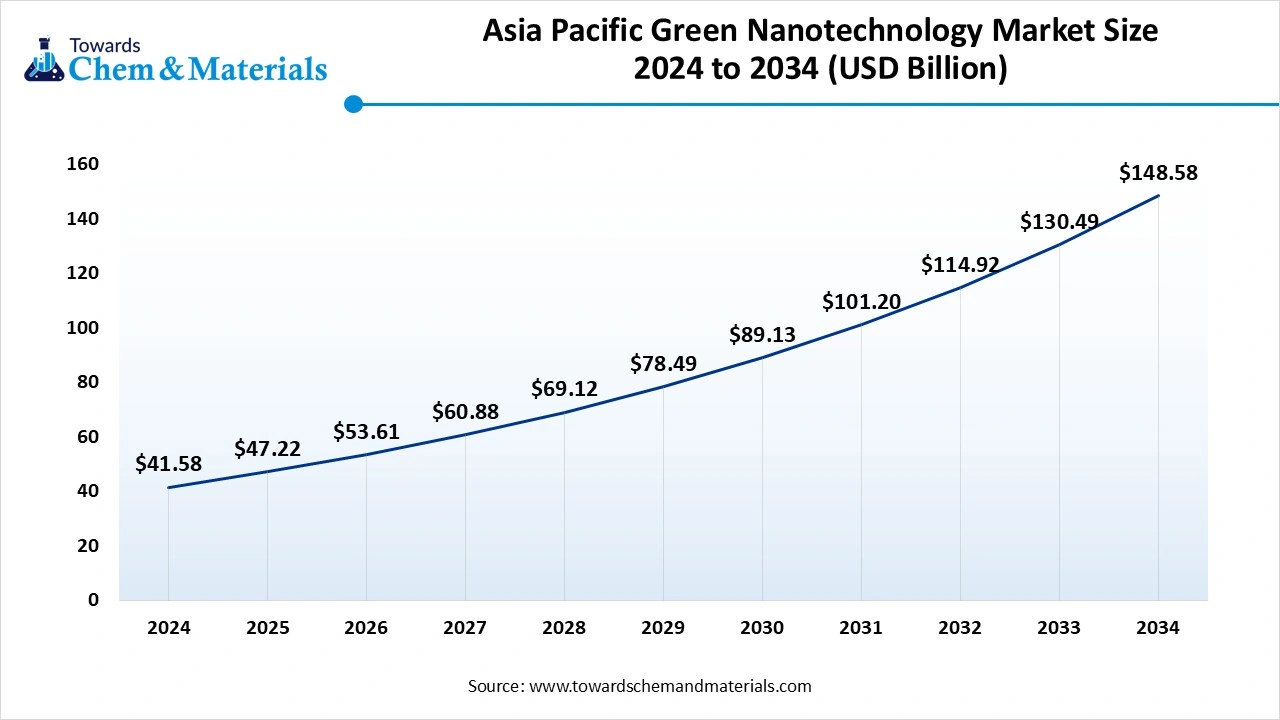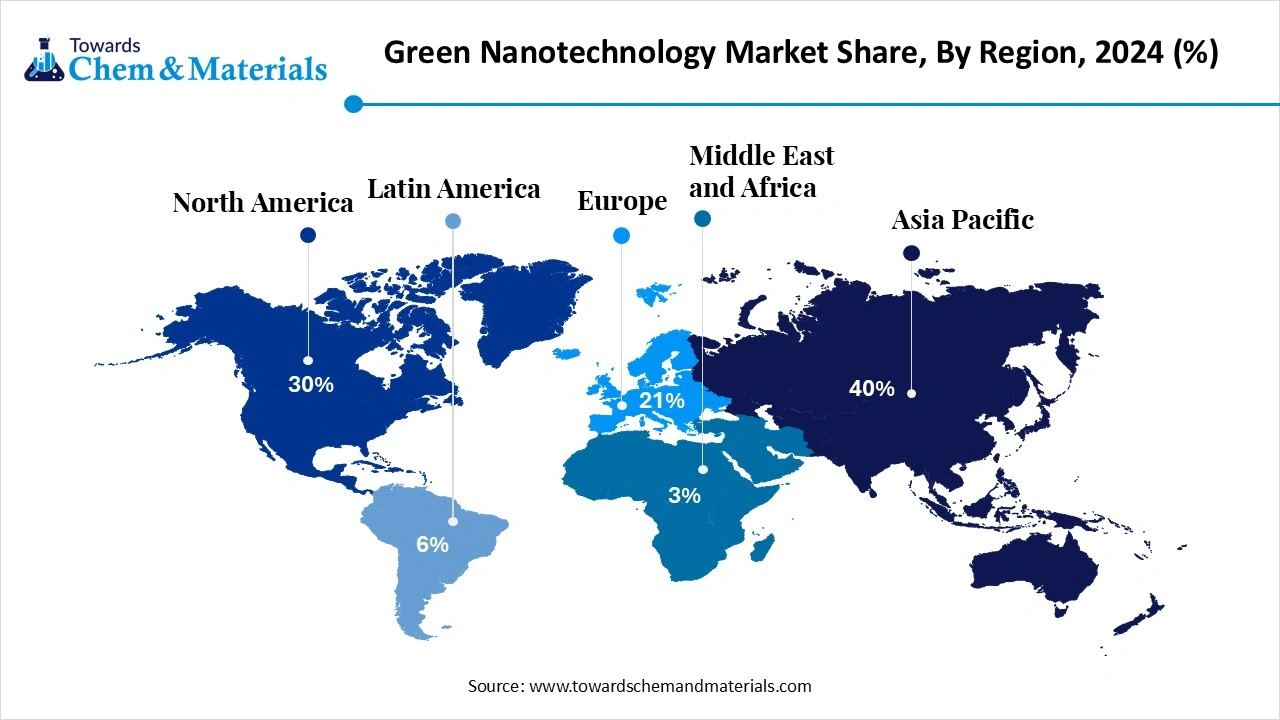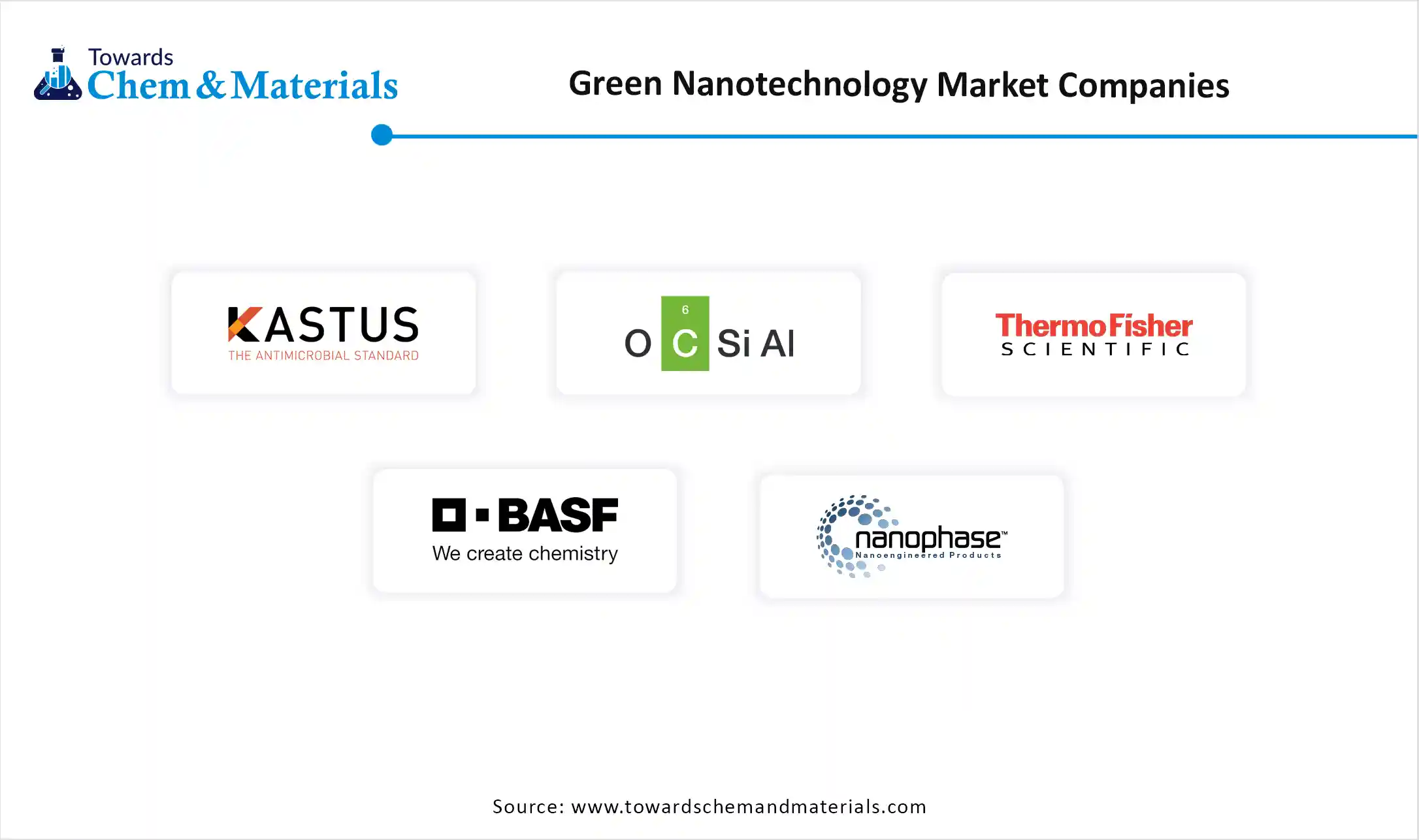November 2025
The global green nanotechnology market size was reached at USD 103.95 billion in 2024 and is expected to be worth around USD 370.42 billion by 2034, growing at a compound annual growth rate (CAGR) of 13.55% over the forecast period 2025 to 2034. Growing demand for sustainable solutions across various sectors is the key factor driving market growth. Also, the surge in investments in research and development, coupled with the ongoing government initiatives, can fuel market growth further.

Green nanotechnology refers to the application of nanotechnology to develop products and processes that are environmentally sustainable and safe. This market focuses on the use of nanomaterials and nanotechnology-based solutions to address environmental concerns, such as pollution control, energy efficiency, waste reduction, and sustainable resource management.
Green nanotechnology enables the creation of energy-efficient materials, low-toxicity products, and more sustainable manufacturing practices. Nanotechnology is transforming the electronics sector with innovations in stretchable and flexible electronics, displays, and energy storage.
| Report Attribute | Details |
| Market Size in 2025 | USD 118.04 Billion |
| Expected Size by 2034 | USD 370.42 Billion |
| Growth Rate from 2025 to 2034 | CAGR 13.55% |
| Base Year of Estimation | 2024 |
| Forecast Period | 2025 - 2034 |
| Dominant Region | Asia Pacific |
| Segment Covered | By Application, By Material, By Technology, By End-User Industry, By Region |
| Key Companies Profiled | Log9 Materials (India), Kastus Technologies (Ireland), OCSiAl (Luxembourg), Thermo Fisher Scientific (USA), BASF SE (Germany), Nanophase Technologies Corp. (USA), QuantumSphere, Inc. (USA), Nanoco Technologies (UK) |
Rise in Government Support and Funding
Nanotechnology and nanoscience are major fields for innovation leaders. Nanotechnology is a prominent component for advanced manufacturing, which is fuelled by an extensive circle of countries such as Canada, China, Australia, and the USA. Furthermore, the government's ongoing support for different green technology projects is creating lucrative market opportunities soon.
The high infrastructure cost of nanomaterials and devices is the major factor hindering the market growth. Synthesizing and developing nanomaterials often involves precise control with advanced techniques on their properties. Moreover, physical methods for designing nanoparticles are expensive, impacting their economic viability and market competitiveness.
Asia Pacific Green Nanotechnology Market Trends
The Asia Pacific green nanotechnology market size was estimated at USD 41.58 billion in 2024 and is anticipated to reach USD 148.58 billion by 2034, growing at a CAGR of 13.58% from 2025 to 2034. Asia Pacific dominated the market with a 40% market share in 2024.

The dominance of the segment can be attributed to the rising research and development (R&D) expenditure along with the expanding manufacturing industries in emerging economies such as China and India. Moreover, the region's effective industrial policies, coupled with factors such as accessible production resources and cost-effective labor, are boosting regional growth further.
China Green Nanotechnology Market Trends
In the Asia Pacific, China led the market due to the rising investments in research & development activities for energy, biomedical, and wastewater treatment applications. Also, the country's semiconductor production is anticipated to minimize the further demand-supply gap. Nanomaterials are utilised in semiconductor manufacturing to improve the magnetoresistance ratio in semiconductors.
North America Green Nanotechnology Market Trends
North America is expected to grow at the fastest CAGR over the forecast period. The growth of the region can be credited to the strong presence of major market players and sustainability and green technology initiatives. Furthermore, access to many renewable resources, such as wind power and solar, is also offering crucial opportunities for green energy projects in the region.
U.S. Green Nanotechnology Market Trends
In North America, the U.S. dominated the market by holding the largest market share due to growing demand for nanomaterials in the healthcare industry. In addition, ongoing technological advancements in nanomaterials will transform several industries due to their extensive range of applications, like the aerospace industry, which in turn is expected to contribute to market expansion.

Which Application Type Segment Dominated the Green Nanotechnology Market in 2024?
The water treatment segment held a 30% market share in 2024. The dominance of the segment can be attributed to the stringent environmental standards and increasing industrial requirements with limited water resources. In addition, the launches of innovative technologies such as remote monitoring, smart water management systems, and digitalization have transformed the segment expansion.
The energy segment is expected to grow at the fastest CAGR over the forecast period. The growth of the segment can be credited to the rising demand for sustainable and clean energy sources and growing concerns over climate change. Also, nanotechnology provides a unique way for improving energy efficiency, enhancing energy storage, and optimizing overall renewable energy production.
Why Nanocomposites Segment Dominated the Green Nanotechnology Market in 2024?
The nanocomposites segment dominated the market with a 35% market share in 2024. The dominance of the segment can be linked to the growing product demand in industries such as automotive, packaging, defense, and aerospace. Additionally, Nanocomposites are increasingly becoming more popular due to their wide range of capabilities, such as strong tensile strength and strong corrosion resistance, which will impact positive segment growth soon.
The nanoparticles segment is expected to grow at the fastest CAGR over the forecast period. The growth of the segment can be driven by the surge in the use of nanoparticles in the pharmaceutical and cosmetics sectors, along with the rapid urbanization across the globe. Furthermore, nanoparticles are widely utilized in the electronics sector because of their mechanical, optical, and electronic properties.
Which Technology Type Segment Held the Largest Green Nanotechnology Market Share in 2024?
The bottom-up fabrication segment dominated the market by holding 40% market share in 2024. The growth of the segment is owing to the ongoing technological innovations in semiconductor manufacturing. Bottom-up fabrication techniques generally involve the self-organization of the building blocks, such as nanoparticles. These building blocks then interact with each other to form larger materials or structures with specific properties.
The hybrid fabrication segment is expected to grow at the fastest CAGR over the forecast period. The growth of the segment is due to the surge in investment by the private and public sectors in fabrication technology. Hybrid nanomaterials like metal oxides, along with metal nanoparticles or carbon nanomaterials, have been utilized to develop highly sensitive gas sensors, which can detect gases like nitrogen dioxide and carbon monoxide.
How Much Share Did the Construction Segment Held in 2024?
The construction segment dominated the market with a 40% market share in 2024. The dominance of the segment can be attributed to the growing demand for green building construction and innovations in nanotechnology. Moreover, smart nano-construction materials have a potential for industrial growth due to their high-end performance, driving segment growth soon.
The consumer goods segment expects the fastest growth over the forecast period. The growth of the segment can be credited to the rising adoption of novel nanotechnology methods to improve agricultural productivity, coupled with the increasing demand for carbon nanotube-based touchscreens globally. This further aids in the surge in use of nanotechnology in semiconductors.

By Application
By Material
By Technology
By End-User Industry
By Region
November 2025
November 2025
November 2025
November 2025